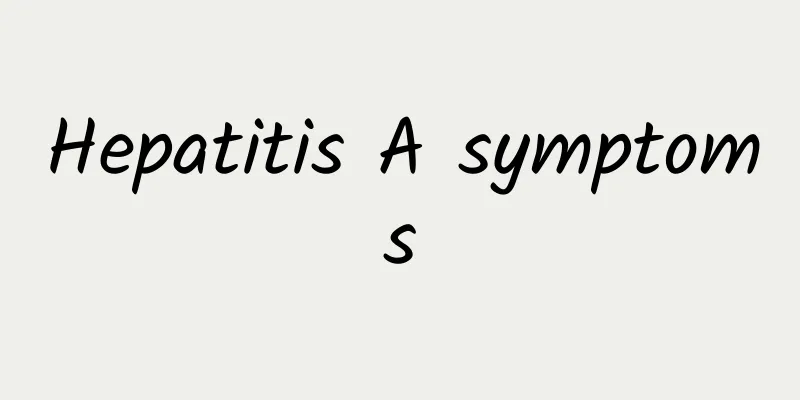Hepatitis A symptoms

|
Hepatitis A is actually generally called hepatitis A in daily life. It is a contagious disease, so we need to pay special attention to the prevention of this disease in life. Do you know some symptoms of hepatitis A? Let’s take a detailed look at some symptoms of hepatitis A. I hope everyone can pay attention to it in life. Although hepatitis A is a contagious disease, this problem can be well solved if we take good care of ourselves in our daily lives, and we don’t need to panic too much. Let’s take a look at the symptoms of hepatitis A and respond to treatment scientifically. Symptoms and signs 1. Acute icteric type (1) Pre-icteric period: After an incubation period of 15 to 45 days (average 30 days), most infected people develop acutely with symptoms such as chills and fever, fatigue, muscle aches, lack of appetite, nausea, aversion to oil, vomiting, and upper abdominal discomfort, which may last for several days to two weeks. A small number of patients have no obvious symptoms. The main signs are tenderness and percussion pain in the liver area. The total number of peripheral blood leukocytes is normal or slightly low, the lymphocytes are increased, abnormal lymphocytes can be seen, urine bilirubin is positive, ALT is elevated, anti-HAV IgM positive. (2) Jaundice stage: About one week after the onset of the disease, the fever subsides, the urine becomes yellow like strong tea, the sclera and skin turn yellow, and the jaundice reaches its peak within 1 to 2 weeks. The liver is enlarged, with tenderness and percussion pain. Some patients have mild splenomegaly, elevated ALT, and serum bilirubin exceeding 17.1μmol/L, which lasts for 2 to 6 weeks. (3) Recovery period: Jaundice subsides, symptoms disappear, and liver function returns to normal, which lasts from 2 weeks to 4 months, and in a few cases up to 6 months. 2. The acute anicteric type is generally milder, with a shorter course and is easy to be ignored. It only manifests as fatigue, loss of appetite, abdominal distension and pain in the liver area. Some patients have no clinical symptoms (subclinical type) but may have enlarged liver. Anti-HAV IgM was positive and ALT was elevated, and total bilirubin was below 17.1 μmol/L. 3. Acute cholestatic hepatitis A The onset is acute, with mild gastrointestinal symptoms, dark yellow urine, obvious yellowing of the sclera and skin, grayish-white stools and itchy skin. Serum bilirubin is significantly elevated, mainly direct bilirubin, serum transpeptidase, alkaline phosphatase, cholesterol, etc. are significantly elevated, ALT is moderately elevated, jaundice persists for more than 3 weeks, and in a few cases for more than 3 months, and other extrahepatic obstructive jaundice is excluded. Hepatitis A can actually affect our health, so active treatment is necessary in life. Therefore, when facing this disease, we only need to fully understand its symptoms to help ourselves solve and treat it in a targeted manner. |
<<: Symptoms of influenza A (H1N1)
>>: Pneumonia vaccine adverse reactions
Recommend
What are the advantages and disadvantages of sweat steaming for the body
Maybe everyone has heard of sweat steaming as a h...
What is the difference between Asparagus cochinchinensis and Ophiopogon japonicus?
There are many plants in our daily life that look...
Side effects of Chinese medicine amber
Amber is also a kind of traditional Chinese medic...
High fever and convulsions
Cold and fever are very common phenomena. Everyon...
How does high blood pressure develop?
Hypertension is a disease that many people will e...
What are Moringa seeds used for?
What are Moringa seeds used for? Recently, many f...
What should I do if I get a sore throat during breastfeeding? What is the best thing to eat?
Although mothers who have given birth take great ...
What to do if you are allergic to royal jelly
In this modern age of knowledge, people's int...
How effective is ultrasound interventional treatment for renal cysts?
Renal cyst is a relatively common type of cyst, w...
What causes brain edema and convulsions?
Disease is a factor that affects people's hea...
What Chinese medicine should I take for Qi deficiency and blood deficiency? Common prescriptions are recommended to you
If female friends suffer from qi deficiency and b...
What's going on when there's a sudden bump on my wrist?
The human body is a sophisticated and fragile ins...
Can allergic rhinitis be cured?
Nowadays, the number of people suffering from rhi...
Why do you need dental crossbite correction?
Crossbite correction is a method of correcting ab...
Tinnitus caused by cervical spondylosis is most effectively treated with five methods
For white-collar workers, cervical spondylosis is...









